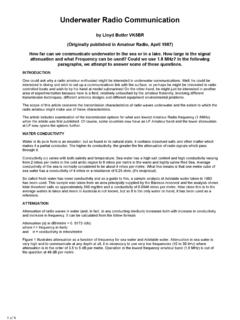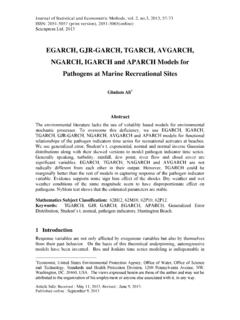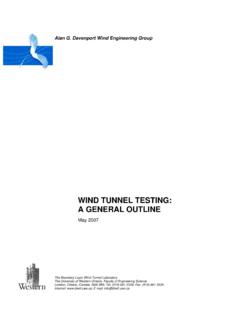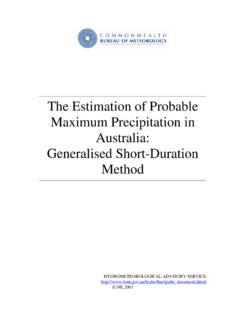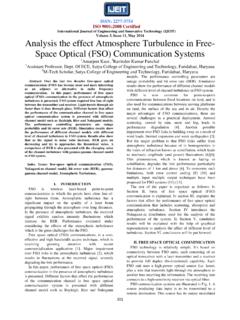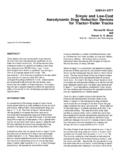Transcription of CONDENSED SOLAR RADIATION DATA BASE FOR …
1 CONDENSED SOLAR RADIATION data base FOR australia by Graham L. Morrison and Alex Litvak Report No 1/1999 SOLAR Thermal Energy Laboratory University of New South Wales Sydney australia CONDENSED SOLAR RADIATION data base for australia UNSW 1 ABSTRACT Australian SOLAR irradiation data catalogued in the Australian SOLAR RADIATION data Handbook has been combined with other meteorological data and organized into CONDENSED one year records of hourly meteorological data (Typical Meteorological Year data ). Each data record lists global SOLAR irradiation on a horizontal surface, direct beam SOLAR irradiation on a sun tracking surface, dry bulb ambient temperature, wet bulb ambient temperature, wind speed and direction and cloud cover. Analysis of the output of SOLAR thermal systems using this CONDENSED input data set is shown to give a reliable estimate of the long term average annual performance of a wide range of SOLAR thermal systems.
2 INTRODUCTION An essential part of the development of computer based SOLAR energy system design and sizing is the acceptance of a common SOLAR RADIATION data base to minimize calculation time and to facilitate comparative studies made by different organizations. The data records used in the Australian SOLAR RADIATION data Handbook are available in computer compatible form, however few users could justify the effort involved in working from this basic data because of the difficulty of manipulating and storing 18 years of hourly records for each location of interest. Inaddition many studies of SOLAR energy systems require concurrent records of SOLAR irradiation and other meteorological data such as temperature , wind speed and cloud cover. Concurrent data was developed by Walsh [1] for 18 locations for the period 1969-1978.
3 Since 1982 five more stations have been added to the Bureau of Meteorology network, however this additional data has not been processed into concurrent records of SOLAR irradiation ,temperature, wind speed and cloud cover. This paper outlines the development of a typical meteorological year CONDENSED SOLAR RADIATION data base consisting of hourly records of concurrent factors for 24 locations in australia . SOLAR RADIATION data SOURCES FOR australia Australian SOLAR RADIATION records have been studied by Walsh et al [1], Roy and Miller [2] and Fick et al [3]. The Australian SOLAR RADIATION data Handbook [3] is the most comprehensive record of data collected by the Bureau of Meteorology and extensive derived SOLAR irradiation characteristics. Long term measurements of global SOLAR irradiation are available for 21 sites in australia [3].
4 Records starting in 1982 or 1983 are also available for Adelaide, Brisbane, Canberra and Kalgoorlie (tables 1 and 2). Before this data can be used for SOLAR system performance analysis missing records must be filled by typical values. A major amalgamation and checking of data available up to 1986 was carried out by Fick et al [3]. This data is available from NERDDP via Techsearch Inc [5]. CONDENSED SOLAR RADIATION data base for australia UNSW 2 SOLAR RADIATION USER REQUIREMENTS The performance of active and passive SOLAR energy systems can be determined by detailed simulation or by correlation models. Most correlation models use monthly average daily SOLAR irradiation data which has been documented for the main population centres in australia [2,6,7].
5 Detailed simulation of system performance usually requires hourly data for the following parameters global horizontal irradiation and beam irradiation dry and wet bulb temperatures wind speed and direction cloud cover The existing data sets compiled by Walsh [1] consists of 10 to 12 years of records for 16 locations however these data files are very large and hence are difficult to use in all except mainframe computer environments. CONDENSED SOLAR RADIATION data SETS SOLAR RADIATION and meteorology data must be measured for many years inorder to obtain representative data of long term average conditions. Once long data records are available the long term average performance of a SOLAR energy system can be determined by simulating the system performance over the full length of data .
6 However the cost of using an entire data set for even one location is prohibitive for users with access to high speed mainframe computers, and the run time is excessive for small computer systems. To reduce the time taken to evaluate long term performance most users rely on a "typical year" of data . Typical meteorological data should have the following features [8] RADIATION , ambient temperature and wind speed should have frequency distributions which are close to the long term distributions. the sequence of daily data should be like the sequences registered at the location. the relationships among the different parameters in the data set should be like the relationships observed in nature. The North American typical meteorological year data was developed by comparing the cumulative distribution function of each year with the cumulative distribution for the long term composite of all available data (typically 23 years of data ).
7 The final year of typical data was generated by combining 12 particular typical months of data . The selection of each month was determined on a weighted average of each statistic, with SOLAR RADIATION contributing one half of the weighting. CONDENSED SOLAR RADIATION data base for australia UNSW 3 SELECTION OF TYPICAL data FROM AUSTRALIAN SOLAR RADIATION RECORDS As SOLAR RADIATION records in australia are relatively short the statistical approach used in the North American typical meteorological year data study could not be reliably applied. An alternative method of selecting typical data is to examine the results of a large number of SOLAR system simulation runs and to select the particular month that produces a result closest to the average for that month. The main problem with this approach is that the relative importance of each parameter may differ for different SOLAR energy systems.
8 However an advantage of this method is that a weighted average selection criteria does not have to be used since the simulation model includes the correct relative weighting of the input parameters. This procedure has been applied to Australian SOLAR RADIATION records using RADIATION on horizontal, latitude slope and vertical surfaces, Heat Tables for 3 collector types and the performance of a SOLAR water heater, as inputs to the procedure. These factors were evaluated for the full data set and used to select the most typical year for each month. The SOLAR collector performance characteristics used to generate typical months ranged from passive/unglazed collectors operating near ambient temperature to a glazed collector operating at 110 C. The three most typical years for each characteristic were determined and the final selection of one year was made by comparing the standard deviation of the global horizontal irradiation for each of the 3 years with the average standard deviation for all appropriate months in the data set.
9 Typical results of this selection procedure for January in Sydney are shown in Table 3, the most typical year in terms of delivered energy is clearly 1981. When the RMS values of the RADIATION are examined (Table 4) 1981 is also seen to be the most typical year. The choice of a particular month is not always as clear as in the above example, some times the best year in terms of mean energy output is not the most typical year in terms of the variation of daily RADIATION and hence the next best year may have to be selected. Wind speed is included in the concurrent data sets, however it was not considered in the typical meteorological year data selection process. This procedure has been applied to 22 locations in the Australian SOLAR data network the monthly components of each TMY data set are listed in table 5.
10 The data for Adelaide, Brisbane and Canberra is based on less than 4 years of data hence the typical year records will need to be updated when additional data becomes available. TIME BASIS OF FILES FROM DIFFERENT SOURCES Unfortunately the time basis of the data depends on the source of the data . data records for Sydney are in Eastern Standard Time while data records for other locations are in Mean SOLAR Time. The time stamp of data records for Adelaide, Brisbane, Canberra and Sydney is the end of the SOLAR integration period. The time stamp for all other locations is the midpoint of the SOLAR integration period. CONDENSED SOLAR RADIATION data base for australia UNSW 4 COMPARISON OF TYPICAL METEOROLOGICAL YEAR AND LONG TERM AVERAGE data Typical meteorological year meteorological data for 3 locations is compared with the long term average data in table 6.




